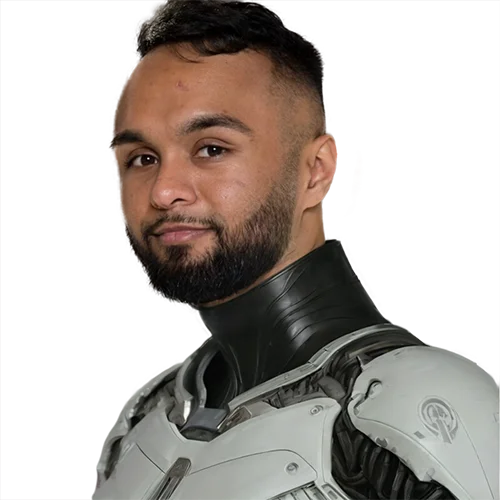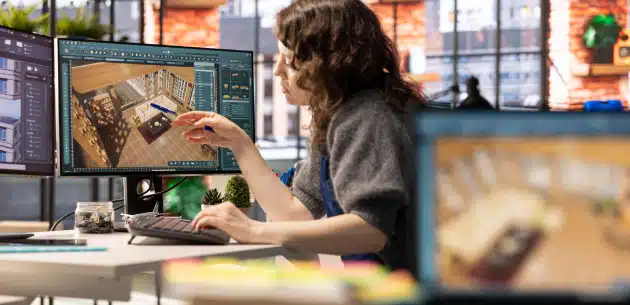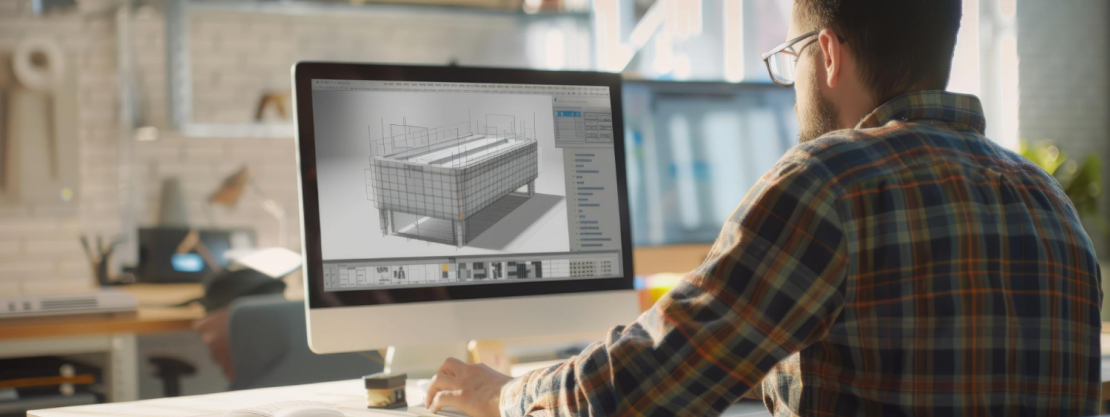
Scrolling through a few static product photos doesn’t cut it anymore. Today’s shoppers expect more, not because they’re picky but because they’re used to real-life experiences. In a store, they can pick something up, turn it over, check out the texture, the details, the size. Online, they’re stuck guessing from a handful of flat images.
That gap between physical and digital is where 3D visualization steps in. It gives customers the power to interact with products in a way that feels real. They can rotate, zoom, and inspect from every angle. It builds confidence, answers questions before they’re asked, and helps people feel good about clicking “buy.”
In 2025 and beyond, this isn’t just a flashy add-on. It’s quickly becoming the new standard for online shopping.
What 3D Visualization Really Is (And Isn’t)
3D product visualization means shoppers can see your product from every angle. Instead of just swiping through a few photos, they can spin it around, zoom in to check details, and move it like it’s right in front of them. It feels more like picking something up in a store than browsing a website.
This is not the same as a regular product video. Videos are one-way. You press play and watch whatever the brand chose to show you. With 3D, the customer controls the view. They explore what they care about, not what you decided to highlight.
And no, this tech isn’t just for huge brands or luxury stores. Thanks to newer tools and apps, 3D models are now affordable and easier to create than ever. Whether you’re selling custom furniture or phone cases, you can bring your products to life for your customers — without breaking your budget.
Why Shoppers Trust What They Can “Touch”
One of the biggest reasons people hesitate to buy online is simple: they can’t see or feel the product like they would in a store. Is the couch too bulky? Will that fabric wrinkle? Does the phone case look cheap up close? Flat photos rarely answer these questions. But 3D visualization can.
Take Crate & Barrel, for example. They use 3D models for many of their furniture items, letting shoppers rotate a sofa, zoom in on the fabric texture, and see how it looks from different angles. That experience gives people the confidence to spend big, because they’re not guessing. They’re seeing the product almost as if it were in their living room.
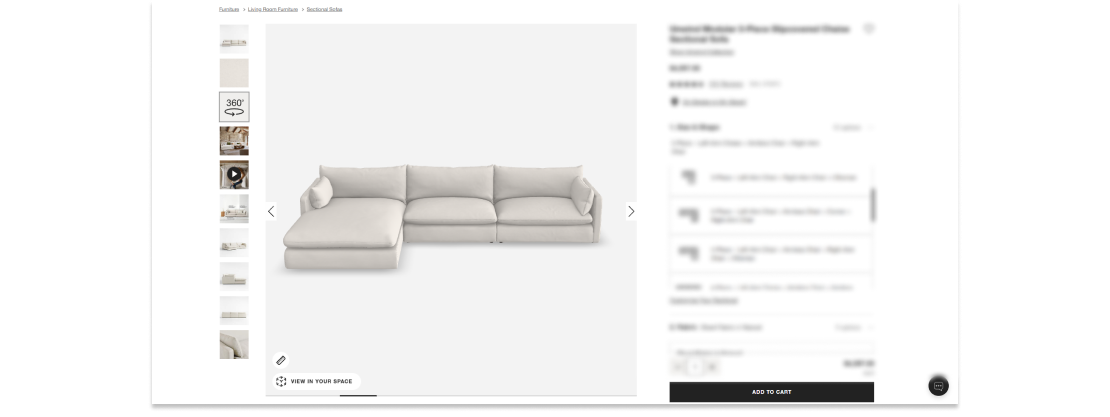 Crate & Barrel uses 3D visualization so shoppers can see furniture from every angle before they buy.
Crate & Barrel uses 3D visualization so shoppers can see furniture from every angle before they buy.
Another example is Nike, For certain shoes, they’ve added interactive 3D views that let customers spin and examine every detail. The laces, the sole, the material, it’s all there. That kind of transparency builds trust.
When shoppers can explore a product, they feel more certain, and that confidence leads to fewer abandoned carts, fewer returns, and happier customers. It also taps into something emotional. The closer a product feels to real life, the more connected a person feels to it. And when someone feels connected, they’re more likely to buy.
How 3D Changes the Way People Shop
3D visualization does more than make products look cool. It changes how people behave while shopping online. When a customer interacts with a 3D model, they stop scrolling and start engaging. They rotate the product, zoom in on details, and take time to explore. That kind of hands-on interaction creates focus, and in an online environment filled with distractions, that’s a big win.
This engagement matters because it creates a stronger connection between the shopper and the product. Instead of passively flipping through photos, they’re actively involved. The more time they spend interacting, the more invested they become. That leads to faster decision-making, fewer hesitations, and a smoother path to checkout.
3D also helps shoppers get what they need without digging through reviews or FAQs. The product answers their questions visually. That simplicity leads to better satisfaction, and in many cases, fewer abandoned carts. For eCommerce brands, it’s not just a better customer experience — it’s a smarter way to sell.
Small Brands Can Afford 3D Visualization (With the Right Approach)
3D visualization can be a powerful upgrade for your online store. While some solutions are built for scale, that doesn’t mean smaller brands are locked out. Like any smart investment, it’s about starting where it makes the most sense and growing from there.
There are different ways to explore 3D depending on your goals and your budget. Platforms like Shopify offer apps with built-in 3D features, and there are freelancers or smaller agencies that can help bring a handful of products to life without overextending your spend. AI-powered tools are also emerging, making it easier to create simple models quickly and affordably.
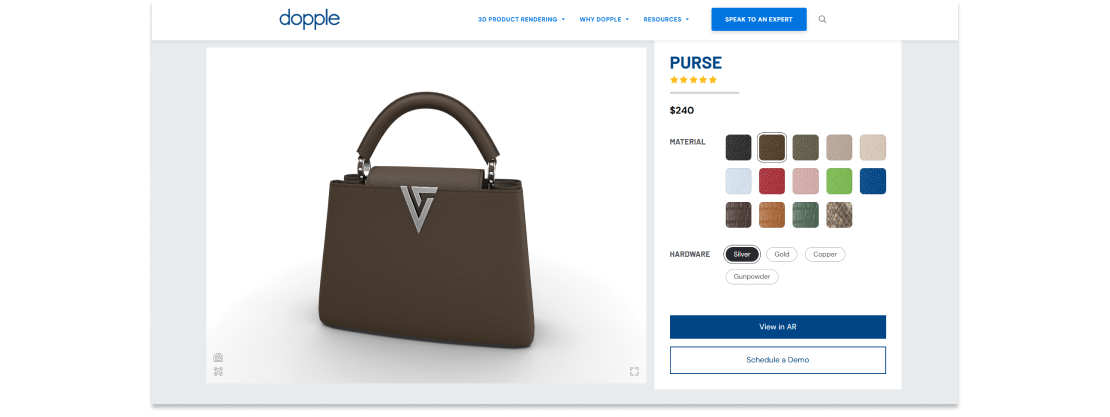 Dopple 3D Visualization demo
Dopple 3D Visualization demo
For brands that are ready for a more advanced solution, our partners like Dopple offer professional-grade 3D visualization. These services are built to deliver high-quality, immersive product experiences and are a great fit for businesses looking to elevate how they present their products online.
Whether you start small or go all in, 3D visualization is no longer just a trend. It’s a smart way to improve product clarity, build trust with customers, and give your store a competitive edge.
The Bigger Picture: 3D, AR, and What’s Next
3D product visualization is not the finish line. It is the foundation for the next wave of online shopping. Augmented reality try-ons, virtual showrooms, and immersive digital stores are all built on top of 3D models.
Shoppers will soon expect to see how a couch fits in their living room or how a pair of shoes looks on their feet using just their phone. These experiences are already being rolled out, and they are only going to become more common. Without high-quality 3D visuals, none of it works.
This is where spatial commerce comes in. Spatial commerce blends physical space with digital shopping. It lets customers browse virtual stores, walk through product showrooms, or place items in their real environment through Augmented Reality (AR). Instead of clicking flat images, shoppers can move around and explore products in ways that feel more natural and hands-on.
Major platforms like Shopify, Apple, and Meta are investing heavily in these technologies. They are building the infrastructure now so businesses can deliver more immersive, interactive experiences later. As this shift happens, customer expectations will rise.
The brands that move early will be ahead of the curve. Adding 3D today is not just a visual upgrade. It is a way to future-proof your store and stay relevant in a rapidly evolving market.
Conclusion: 3D Isn’t the Future — It’s the Now
3D visualization is no longer just a trend or a nice-to-have. It builds trust by helping shoppers understand what they’re buying. It increases sales by boosting confidence and reducing hesitation. And it lowers returns by setting clear expectations before the product ever ships.
What used to be reserved for big-budget brands is now within reach for smaller businesses willing to take the first step. Whether you start with one product or roll it out across your catalog, 3D can give your store a real edge.
The eCommerce world is moving fast. Shoppers are expecting more, and stores that deliver immersive, interactive experiences will be the ones that stand out. If you’re looking for a way to improve your product pages, reduce returns, and help customers feel more confident, now is the time to explore what 3D can do for your business.

 Eashan Mehta
Eashan Mehta